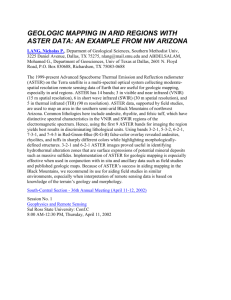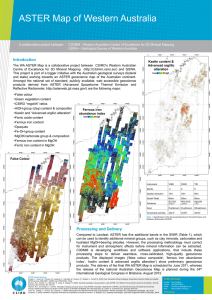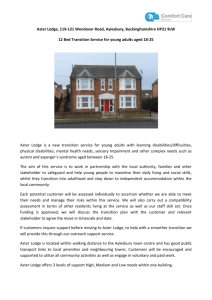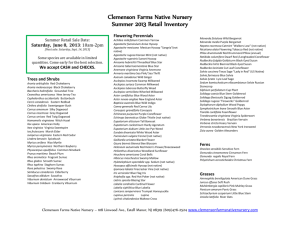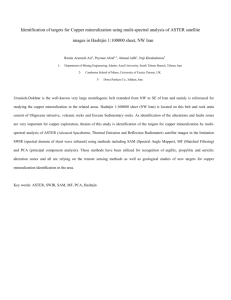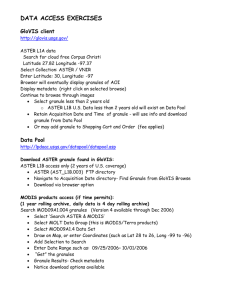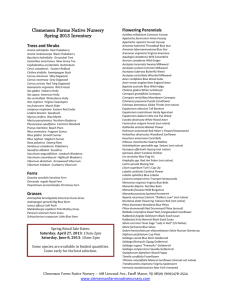Code Aster User Manuel
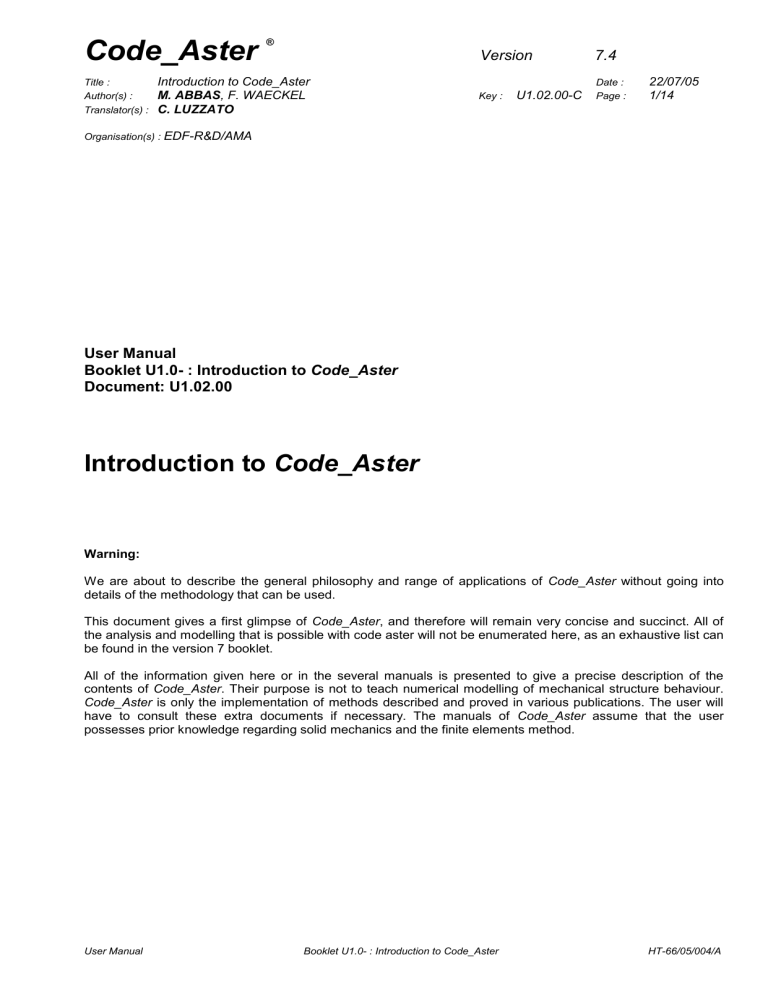
Code_Aster ®
Title :
Author(s) :
Introduction to Code_Aster
M. ABBAS, F. WAECKEL
C. LUZZATO
Translator(s) :
Organisation(s) : EDF-R&D/AMA
User Manual
Booklet U1.0- : Introduction to Code_Aster
Document: U1.02.00
Version
Key :
7.4
Date : 22/07/05
U1.02.00-C Page : 1/14
Introduction to Code_Aster
Warning:
We are about to describe the general philosophy and range of applications of Code_Aster without going into details of the methodology that can be used.
This document gives a first glimpse of Code_Aster , and therefore will remain very concise and succinct. All of the analysis and modelling that is possible with code aster will not be enumerated here, as an exhaustive list can be found in the version 7 booklet.
All of the information given here or in the several manuals is presented to give a precise description of the contents of Code_Aster . Their purpose is not to teach numerical modelling of mechanical structure behaviour.
Code_Aster is only the implementation of methods described and proved in various publications. The user will have to consult these extra documents if necessary. The manuals of Code_Aster assume that the user possesses prior knowledge regarding solid mechanics and the finite elements method.
User Manual Booklet U1.0- : Introduction to Code_Aster HT-66/05/004/A
Code_Aster ®
Title :
Author(s) :
Introduction to Code_Aster
M. ABBAS, F. WAECKEL
C. LUZZATO
Translator(s) :
Table of contents
Version
Key :
7.4
Date : 22/07/05
U1.02.00-C Page : 2/14
1 Study of the mechanical behaviour of structures ................................................................................... 3
1.1
A general code ................................................................................................................................. 3
1.2
Code_Aster calculation methodology .............................................................................................. 3
1.3
Phenomena, models, finite elements and behaviours ..................................................................... 4
1.3.1
Notions 4
1.3.2
The mechanical phenomenon ................................................................................................ 4
1.3.3
Associated phenomena .......................................................................................................... 6
1.3.3.1
Thermal phenomenon ................................................................................................ 6
1.3.3.2
Accoustic phenomenon .............................................................................................. 6
1.3.4
The « coupling » of phenomena ............................................................................................. 6
1.3.4.1
Internal chainings in Code_Aster ............................................................................... 6
1.3.4.2
The real couplings ...................................................................................................... 7
1.4
Several analysis methods ................................................................................................................ 7
1.4.1
Static / Quasi-Static / Transitory ............................................................................................. 7
1.4.2
Dynamics : physical basis or modal basis notions.................................................................. 7
1.4.3
FOURIER mode decomposition ............................................................................................. 8
1.4.4
Sub-structuring ....................................................................................................................... 8
2 A solving method: finite elements .......................................................................................................... 9
2.1
A parameterised implementation of the finite elements method ...................................................... 9
2.2
An extended finite element library .................................................................................................... 9
2.2.1
Continuous mediums .............................................................................................................. 9
2.2.2
Structural components .......................................................................................................... 10
2.2.3
Modelling joints ..................................................................................................................... 10
2.3
Heterogeneous modelling .............................................................................................................. 10
3 Project tools ......................................................................................................................................... 11
3.1
Additional tools and mesh operations ............................................................................................ 11
3.2
Material data catalogue .................................................................................................................. 11
3.3
Result exploitation and processing ................................................................................................ 11
3.3.1
Field operations .................................................................................................................... 11
3.3.2
Value extraction .................................................................................................................... 11
3.3.3
Printing the results ................................................................................................................ 11
3.4
Result verification, and quality control ............................................................................................ 11
4 Dedicated tools .................................................................................................................................... 13
4.1
Definition and operation process ................................................................................................... 13
4.2
Available dedicated tools ............................................................................................................... 13
5 Exchanges with other software ............................................................................................................ 14
5.1
Exchange modes ........................................................................................................................... 14
5.2
The software interfaced with Code_Aster ...................................................................................... 14
User Manual Booklet U1.0- : Introduction to Code_Aster HT-66/05/004/A
Code_Aster ®
Version 7.4
Title :
Author(s) :
Introduction to Code_Aster
M. ABBAS, F. WAECKEL
C. LUZZATO
Key :
Date : 22/07/05
U1.02.00-C Page : 3/14
Translator(s) :
1 Study of the mechanical behaviour of structures
1.1 A general code
Code_Aster is a general code directed at the study of the mechanical behaviour of structures.
The main range of application is deformable solids: this explains the great number of functionalities related to mechanical phenomena. However, the study of the behaviour of industrial components requires a prior modelling of the conditions to which they are subjected, or of the physical phenomena which modify their behaviour (internal or external fluids, temperature, metallurgic phase changes, electro-magnetic stresses ...). For these reasons, Code_Aster can « link » mechanical phenomena and thermal and acoustic phenomena together. Code_Aster also provides a link to external software, and includes a coupled thermo-hydro-mechanics kit.
Even though Code_Aster can be used for a number of different structural calculation problems (general purpose code), it has been developed to study the specific problems of components, materials and machines used in the energy production and supply industry. Thus, preference has been given to the modelling of: metallic isotropic structures, geo-materials, reinforced concrete structure components and composite material components
Thermal and mechanical non linear analysis are the main features of Code_Aster : simple but effective algorithms have been developed to enable quick processing. Note the creators did not want for the algorithms to function merely as independent “black boxes”. For complex projects, it is necessary to understand the operations conducted by the code so that they can be controlled in the most efficient manner: users should refer to the theoretical manuals of the Reference Manual for information about models and methods.
The label of Quality Assurance for industrial studies has several advantages:
Availability of a fixed reference version of the code, with an associated documentation,
Availability of complete algorithms, un-modifiable but parameterised
Commands which are independent from the field of use
Extensive model databases.
1.2 Code_Aster calculation methodology
A structural calculation performed with Code_Aster corresponds to a succession of commands previously defined by the user as text in the « command file ». The interpretation engine for this file is the PYTHON script language. It is therefore possible to use all of the functionalities available in
PYTHON. See documents [U1.03.01] and [U1.03.02] as well as the examples from [U1.05.00] and
[U1.05.01] for more information. Each command (example: reading the mesh, assigning material data, linear static calculation) produces a « concept result ». This concept is a compilation of data structures that the user can manipulate and reuse in future commands (example: the mesh, the material data field, the displacement field)
The syntax for all of these commands is described and commented in documents U4 and U7 of the
User documentation.
To increase user friendliness, there are general commands which comprise a succession of ad’hoc operations, applicable for a certain number of specific cases (example, for linear statics - the
MECA_STATIQUE command, for non linear statics – the STAT_NON_LINE command, for non linear thermal problems – the THER_NON_LINE command, etc.). Certain commands are completely integrated within the code, others are PYTHON macro-commands. The latter only manage the execution of the different unit commands (just like MACRO_MATR_ASSE which can calculate and assemble mass, dampening and stiffness matrices of a structure).
There are also some macro commands which are specific to particular applications (see [§4]).
User Manual Booklet U1.0- : Introduction to Code_Aster HT-66/05/004/A
Code_Aster ®
Version 7.4
Title :
Author(s) :
Introduction to Code_Aster
M. ABBAS, F. WAECKEL
C. LUZZATO
Key :
Date : 22/07/05
U1.02.00-C Page : 4/14
Translator(s) :
Once a calculation has been completed, it is often possible to supplement the obtained « result concept » by adding further ensuing calculations. For example, using a displacement field and gauss point constraints obtained in the mechanical calculation, the user can calculate the deformation field, the constraint field interpolated with the nodes, etc. Doing so is called operating an « option ». Such opti ons are named by using the “what_where_how” nomenclature (example: the option
EPSI_NOEU_DEPL is used to obtain the deformation at the nodes using the displacement values).
1.3 Phenomena, models, finite elements and behaviours
1.3.1 Notions
A « phenomenon » is a family of physical problems relying on the same type of unknown (and associated to the same type of conservation equation). For example, the mechanical phenomenon relies on displacement unknowns; the thermal phenomenon relies on temperature unknowns. The number of unknowns of a type can vary according to the modelling method used (example: we only need one temperature unknown per node when working in 3D, but we use three unknowns for hulls).
Note:
When considering coupled thermo-hydro-mechanical problems, all of the associated conservation equations are grouped under the label of “mechanical” phenomenon.
We call modelling the manner in which the continuous equations governing a phenomenon are discretized, sometimes using complementary assumptions (plane deformation, beam models, shell models). Examples of 3D mechanical models are: 3D, 2D plane deformations, 2D plane constraints, 3D shells, plates, Euler Beams, Timoshenko Beams, pipes, etc... Each model contains its own set of degrees of freedom: for example, 3 axis of displacement for models of continuous medium, 3 displacements and rotations for 3D shells, etc.
The phenomenon/modelling couple allows a bijective assigning of a type of finite element to each type of mesh element.
In Code_Aster , a « finite element” for a said model is defined by:
The nature of the support mesh element(representing a volume or a boundary: hexahedra, tetrahedral, triangle, quadrangle, segment...). This information is topologic (it excludes the number of nodes);
Laws for interpolation of unknowns (form functions) ;
The calculation « options » that the element « knows » how to calculate (the operations for which the adequate integral calculations have been programmed: for example, elementary rigidity terms, elementary force terms, elementary surface force terms, elementary mass terms).
Note that Code_Aster assigns boundary conditions and border loading to specific border elements, rather than to the frontiers of finite elements of volume.
Behaviour is originally a physical notion linked to the properties of the material. It then expresses itself in a mathematical way. For example, in mechanics, a constitutive equation is a relationship which links the constraint field to the deformation field, either directly (elastic behaviour) or indirectly (incremental behaviour). During the calculation, the behaviour relationship is expressed for each Gauss point. In thermal problems, we used the term “behaviour” to express the physical domain linked to the resolution of the conduction-diffusion model equation: the two main groups of behaviours are thermal behaviours
(sometimes coupled with hydration) and drying.
1.3.2 The mechanical phenomenon
The modelling of mechanical phenomena has two main purposes:
Determining the internal state of the structure, and the applied constraints for every point of the structure, when subjected to operating constraints. Knowing the applied constraints allows studying the mechanical behaviour of the structure with reference to:
User Manual Booklet U1.0- : Introduction to Code_Aster HT-66/05/004/A
Code_Aster ®
Title :
Author(s) :
Introduction to Code_Aster
M. ABBAS, F. WAECKEL
C. LUZZATO
Translator(s) :
Version
Key :
7.4
Date : 22/07/05
U1.02.00-C Page : 5/14
- Specific construction rules for each type of structure, especially the Rules of Construction and Conception (RCC...) ;
- The danger of defects and crack propagation: inherent defaults due to the elaboration of the component or structure (inclusions, geometric imperfections...) or resulting from normal operation (crack propagation, erosion...) ;
- The study of behaviour when subjected to cyclic loading, and the analysis of fatigue ;
- The prediction of maximum load with evolution of the internal state.
Determining the deformed configuration of the loads or boundary conditions caused by a permanent load (static) or resulting from a slow evolution (quasi-static) or resulting from a fast evolution (dynamic). Knowing the deformed configuration and the eventually corresponding speeds and accelerations allows continuing mechanical behaviour analysis with reference to:
- The vibratory and acoustic behaviour;
- The transmission of stresses to other structures or components ;
- The impact risk with neighbour structures to determine operating anomalies that could arise from this.
The levels of modelling which appear in the study of this phenomenon are:
The representation of the structure using geometrical shapes, where several modes of representation can coexist:
- Continuous medium corresponding to a three dimensional geometry, or a two dimensional geometry with different assumptions (plane constraints, plane deformations, complete axis symmetry, or adapted to the decomposing of the FOURIER mode loads).
- Structural elements corresponding to a medium with an intermediate layer, a medium with intermediate fibbers or a discretized medium.
The representation of the behaviour of materials, which can be different, in the whole of the structure. The behaviour relationships used enable us to simulate different operating conditions. Many behaviour relationships are available (cf. sheets): linear and non linear elasticity, non linear hyper-elasticity, visco-elasticity, elasto-plasticity, elasto-visco-plasticity, damages. Behaviour relationship parameters can usually depend on « pilot » variables, such as temperature, metallurgic state, degree of hydration or of drying of concrete, fluence, etc.
The representation of loading and limit conditions. Some functionalities enable the user to show, in all points of the structure and in a general coordinate system or a coordinate system defined by the user:
- The DIRICHLET conditions: imposed displacement or linear relationships between displacement components.
- The NEUMANN conditions: punctual lor linear surface imposed load which represents pressure loads.
- Volume loads which represent gravity and the centrifuge force of rotational bodies.
The boundary conditions and loading can depend on time (or on frequency) or on one or several position variables.
The non linearities which are taken into account in mechanical phenomena are the behaviour non linearities and the geometric non linearities (important displacements and rotations, important deformations, contact and friction, buckling).
User Manual Booklet U1.0- : Introduction to Code_Aster HT-66/05/004/A
Code_Aster ®
Version 7.4
Title :
Author(s) :
Introduction to Code_Aster
M. ABBAS, F. WAECKEL
C. LUZZATO
Translator(s) :
1.3.3 Associated phenomena
Key :
Date : 22/07/05
U1.02.00-C Page : 6/14
Functionalities allowing the modelling of phenomena usually associated to mechanical phenomena has been included in Code_Aster . These give a more precise representation of the operating environment of the mechanical components.
1.3.3.1 Thermal phenomenon
The thermal phenomenon is used to determine the thermal response of a solid medium subjected to a permanent regime (stationary problem) or a transitory regime (evolutive problem). We will model conduction in solids, convective heat exchanges between layers, and thermal radiation in infinite space.
The thermal phenomenon can include the model of the metallurgic phase change of steels during heating or cooling. This simulates thermal treatment operations or welding (identification of the behaviour is based on the TRC experimental diagrams).
Using the solved equations and analogy, the thermal phenomenon can also be used to model hydration
(the unknown is the degree of hydration) or the drying of concrete (the unknown is the water concentration).
1.3.3.2 Accoustic phenomenon
The modelling of the acoustic phenomenon is done for two things:
The study of acoustic propagation in closed space corresponding to the HELMHOLTZ equation for a compressible fluid, within a range of propagation bearing a complex topology. If the pressure fields are known, we can continue the acoustic analysis to determine :
- The noise level field (expressed in dB),
- The active and reactive acoustic intensity fields.
The study of coupled 3D vibro-acoustic problems corresponding to the vibration behaviour of a structure in a domain limited to non viscous compressible fluids.
1.3.4
The « coupling » of phenomena
To avoid any ambiguity, we shall distinguish:
The chaining of two phenomena: prior study of a first phenomenon whose results will be used as data for the second phenomenon.
The coupling of two phenomena: simultaneous solving of two phenomena with coupled equations (cf. [§1.3.4.2]).
1.3.4.1 Internal chainings in Code_Aster
Chaining can be done within Code_Aster or between Code_Aster and an external software (cf. [§5.2]).
The chainings that can be done from within Code_Aster are the following:
Thermal – mechanical: all of the material’s mechanical characteristics can depend on temperature. The available algorithms can use theprior thermal calculation results as data in the mechanical calculatio ns (anelastic deformation: thermal dilation, concrete withdrawal…).
The thermal and mechanical calculations can be performed on different types of mesh,
Thermal - metallurgy: the proportions of the different steel phases are calculated after a thermal calculation,
Thermal - metallurgy - mechanical : acknowledgment of four mechanical changes due to metallurgic transformation (deformation during phase change, mechanical characteristic modifications, transformation plasticity, restoration of metallic cold rolling),
electrical - mechanical : integrated with the mechanical phenomenon, the electrical chaining is limited to the recognition of the LAPLACE forces induced by short circuit current in electrical cables,
fluid-mechanical: assigning pressure fields to a wall deduced through a fluid mechanics calculation.
User Manual Booklet U1.0- : Introduction to Code_Aster HT-66/05/004/A
Code_Aster ®
Version 7.4
Title :
Author(s) :
Introduction to Code_Aster
M. ABBAS, F. WAECKEL
C. LUZZATO
Translator(s) :
1.3.4.2 The real couplings
Porous medium
Key :
Date : 22/07/05
U1.02.00-C Page : 7/14
Saturated or non saturated porous medium (geo-materials, ground, and concrete) must be studied by coupling the three equations of mechanics, thermal analysis and hydraulics. The user chooses which behaviour he wants to use from a list of thermo-hydro-mechanical models (THM). He can then choose if he wants to take into account the temperature, or if he wants to represent one or two pressures. The choice of each of the behaviours associated with the selected phenomena is also done by the user.
Fluid-structure interaction
Three types of couplings are available in the fluid-structure interaction domain:
The Eigen mode calculation for a structure containing (or submerged in) an immobile fluid
(with or without free surface),
The calculation of the vibrations of a structure in a flow, and the estimation of the damages due to vibration fatigue or wear,
The acknowledgement of a boundary condition of the type ‘infinite fluid domain’.
1.4 Several analysis methods
1.4.1 Static / Quasi-Static / Transitory
To create the different models, there exist several analysis methods which correspond to different constraint application processes.
Static analysis : corresponds to permanent loads seen in stationary thermal problems and thermomechanics problems. For linear analysis, the obtained results can be linearly combined, and can be used to describe the initial state of an evolving process.
Quasi-static analysis : implicit incremental algorithms can be used for all mechanical processes where inertial problems can be neglected. These are necessary to solve equations with non linear behaviour and with evolving loading and boundary conditions.
Transient analysis : used in linear and non-linear thermal problems, where the metallurgic effects of metals and the hydration and drying of concrete can be taken into account. This is also used in thermohydro-mechanics when neglecting the effects of inertia on the mechanical part.
1.4.2 Dynamics : physical basis or modal basis notions
Dynamical analyses are the study of processes where the effects of inertia and propagation must be taken into account (vibration mechanics, acoustics).
A physical basis analysis is the resolution, in the usual basis, of equations of the physical degrees of freedom. A modal basis analysis relies on the prior calculation of the Eigen values and vectors of the structure, and consists in projecting the equations on an Eigenvector basis : the number of degrees of freedom of the system to be solved is proportional to the size of the modal basis that has been used. It is necessary that the chosen modal basis be large enough to reproduce the main physical phenomena: there exist modal basis quality criteria which can be referred to (cf. [§3.4.3]).
For these two types of modal basis analysis, the calculation of the response can be completed temporal or harmonic manner (when linear).
For seismic analysis, we can also see the problem as one with imposed movement in a relative reference (with no influencing motion).
User Manual Booklet U1.0- : Introduction to Code_Aster HT-66/05/004/A
Code_Aster ®
Version 7.4
Title :
Author(s) :
Introduction to Code_Aster
M. ABBAS, F. WAECKEL
C. LUZZATO
Key :
Date : 22/07/05
U1.02.00-C Page : 8/14
Translator(s) :
Linear dynamic analysis can be performed by including the effects of the initial static constraints calculated previously (geometric rigidity second order terms, centrifugal stiffening).
Two analysis methods are possible when dealing with non linear problems:
Analysis by modal recombination with localised non linear boundary conditions, to simulate shock problems,
Non linear dynamic analysis in physical basis.
1.4.3 FOURIER mode decomposition
The Fourier mode analysis is used to calculate the linear response of an axis symmetric geometric structure subjected to non axis symmetric loads by meshing only one section of the structure.
In practise, the load is decomposed in Fourier series and a solution is computed for each Fourier mode.
The global response is then obtained by recombining all of the results for each mode.
1.4.4 Sub-structuring
Sub-structuring consists in grouping several finite elements inside a macro-element and condensing all of their rigidity upon the degrees of freedom (less numerous) of the macro-element.
Solving the general problem is then limited to solving the unknowns carried by the macro-element, to then independently calculate each of the unknowns carried by the « sub » elements.
The advantage of this method is the improvement in time and memory efficiency, especially when the structure is constructed from elements copied several times by translation or rotation.
In dynamics, the modal analysis and the transitory or harmonic response calculation can be accomplished by means of usual dynamic sub-structuring and using the methods of Craig-Bampton,
Mac Neal or the interface mode method.
For cyclically repeating structures, the available methods allow the calculation of the eigen modes of the general structure using the dynamic behaviour of an original sector.
User Manual Booklet U1.0- : Introduction to Code_Aster HT-66/05/004/A
Code_Aster ®
Version 7.4
Title :
Author(s) :
Introduction to Code_Aster
M. ABBAS, F. WAECKEL
C. LUZZATO
Key :
Date : 22/07/05
U1.02.00-C Page : 9/14
Translator(s) :
2 A solving method: finite elements
The finite elements method is the only currently available method to solve the problems mentioned earlier.
2.1 A parameterised implementation of the finite elements method
A great effort was made to properly parameter the implementation of the finite elements method. The calculation options necessary to each analysis (static, quasi-static, dynamic) and to each phenomenon
(mechanic, thermal, acoustic) are processed globally and for all the structure, whatever the models selected for a particular study.
Some of the possibilities offered by such an architecture are:
An independence between discretisation topology (« meshing ») and the interpretation properties of the finite elements a ssigned to these mesh elements (« model »). This allows the use of a great diversity of models on a same mesh,
The diversity of the behaviour relations and material properties that can be used in one model,
The processing of boundary conditions and loading using specific finite elements at the borders, to allow locating them easily, specifically in continuous mediums.
A systematic procedure allowing to process the dependency of material properties and boundary conditions on other parameters (temperature, time, space variables),
All of the models can be used with different resolution algorithms thanks to a specific data structure.
Note that dualisation is the currently privileged method to process boundary conditions. It allows representing all systems of linear relations of the discretised unknowns. This is used specifically for the linking of different models, or to acknowledge additional local assumptions (plane continuous medium face...). For linear calculation, we can also use an additional method based on the elimination of imposed degrees of freedom.
There are two direct methods and one iterative method, which account for the numbering of unknowns, the storing of assembled matrices and the resolution of the linear systems on which depend the different algorithms:
Multi-frontal method,
LDL T factorisation,
Preconditioned conjugated gradient (iterative method).
The FETI Solver, version 7.4, is also available for domain decomposition (limited to linear cases and to certain types of boundary conditions).
Renumbering algorithms are associated with these methods to optimise the memory used to store the matrices.
2.2 An extended finite element library
The finite element library is parameterised so that the available discretised formulations of the phenomena may be assigned to the mesh elements.
2.2.1 Continuous mediums
A portion of a 3D or 2D structure which is treated as a volume is called a continuous medium.
3D models are the simplest forms of continuous medium, as they do not require any additional assumptions. In 2D models, there is one equation less, but additional assumptions are required: for example, plane deformations or plane constraints for mechanics, and axis symetry for thermal problems and mechanics.
User Manual Booklet U1.0- : Introduction to Code_Aster HT-66/05/004/A
Code_Aster ®
Version 7.4
Title :
Author(s) :
Introduction to Code_Aster
M. ABBAS, F. WAECKEL
C. LUZZATO
Key :
Date : 22/07/05
U1.02.00-C Page : 10/14
Translator(s) :
Some elements exist which take into account discontinuities (eg: cracks) using the level-sets method
(XFEM elements).
2.2.2 Structural components
Structural components include assumptions on 3D kinematic behaviour (representing more or less accurately flexion, torsion, shear stress, and warping phenomena).
These components can be classified in three categories:
intermediate leaf elements (plates, shells) : each type of element depends on assumption made about the variation of thickness, which allows to calculate all of the values from the one taken from the medium leaf (and eventually the upper and lower faces in thermal problems).
Medium fibre elements (bars, beams, pipes, cables) : for each transverse section, the assumptions link the values of the unknowns for all points to the value of the medium fibre,
Discrete elements (weights, springs, dampeners, …) : characteristics in any Cartesian coordinate system can be inserted on punctual meshes.
2.2.3 Modelling joints
With the implementation of the Finite Elements method, structures modelled with different kinds of mechanical elements (continuous medium or structural elements) can be processed. Because the finite element joint depends on different degrees of freedom for a said node, it can be created by writing linear relations specific to the nature of the joint. A specific methodology has been developed to communicate as clearly as possible (in the least square sense) the torsor efforts. Thanks to this, we can accurately represent the joint between a 3D medium and beams, sheets, hulls or pipes, as well as hull-beam, hull-pipe or beam-pipe joints.
The ARLEQUIN method allows joining different meshes and/or phenomena.
2.3 Heterogeneous modelling
We use homogenisation technique to cheaply model networks of pipes submerged in an incompressible fluid, multi layer composite hulls, or multi fibre beams.
User Manual Booklet U1.0- : Introduction to Code_Aster HT-66/05/004/A
Code_Aster ®
Version 7.4
Title :
Author(s) :
Introduction to Code_Aster
M. ABBAS, F. WAECKEL
C. LUZZATO
Translator(s) :
3 Project tools
Key :
Date : 22/07/05
U1.02.00-C Page : 11/14
3.1 Additional tools and mesh operations
A mesh in Code_Aster is defined as: a list of nodes and their coordinates and a list of mesh element shapes and their topology. To these entities we add the notions of node groups and mesh element groups. These groups enable assigning different modelling characteristics (finite elements, materials, boundary conditions, loads…) and simplify result analysis (selective component extraction). With this setup, we can build meshes manually and without hassle, or by using the interface for commercial mesh generators (Gibi, I-DEAS, GID) or free mesh generators (GMSH).
The user can create node groups or mesh element groups at any time during the calculation thanks to logical or geometrical criteria. We can also modify the data structure containing the mesh: coordinate system change, adding more nodes to a mesh, creating new mesh elemnts or mesh element groups, destroying mesh elements, etc…. Adding and removing material is therefore very simple to accomplish.
3.2 Material data catalogue
A material data catalogue with quality assurance gives the user access to the values of behaviour law parameters for several materials usually used in such projects. The characteristics of the material can be directly included in the command file thanks to a specific operator. For the free version, only the catalogue structure is available; all of the material data shall have to be supplemented by the user.
3.3 Result exploitation and processing
3.3.1 Field operations
The calculated fields can be used in all sorts of algebraic combinations. For example, for linear calculations, we can deduce an intricate load response from the separate load responses which constitute it.
3.3.2 Value extraction
Result field extraction operations are available for nodes or mesh elements. It is also possible to define an observation path independently from the initial mesh. Different calculations can be applied to the extracted fields (mean value, standardstandard deviation, tensorial invariants, change to local coordinate system, etc...). For temporal or frequential evolutions, it is possible to extract the deformed shape for one instant (a frequency) or the response for a precise quantity.
3.3.3 Printing the results
The results can be printed in a clear manner, or in specific formats associated to several visualisation tools (Gibi, I-DEAS, GMSH or ENSIGHT). The user can add personalised titles, containing information automatically extracted from the project, to the printed results. Several tools are available to limit the impression to specific portions of calculated fields.
Graphs can also be created in various formats (postscript or other image format) using the Xmgrace graph generator.
3.4 Result verification, and quality control
There are several functionalities available to verify the quality of the obtained results or simplify the project.
User Manual Booklet U1.0- : Introduction to Code_Aster HT-66/05/004/A
Code_Aster ®
Version 7.4
Title :
Author(s) :
Introduction to Code_Aster
M. ABBAS, F. WAECKEL
C. LUZZATO
Translator(s) :
Error estimation and adaptive mesh
Key :
Date : 22/07/05
U1.02.00-C Page : 12/14
There are two categories of error estimators. Used in combination with the refinement/coarsening software HOMARD (the chaining is integrated in Code_Aster via macro commands), they can adapt the mesh during the calculation to obtain a distinct precision with minimal cpu cost.
Verification of the quality of a modal base
Modal basis verification criteria insure that the number of Eigen modes used for the calculation accurately represent the studied phenomenon.
Using incompatible meshes
A calculation started on a first mesh can be continued on a second mesh using projection operators.
We can thus use different meshes for thermal and mechanical problems (by including, for example, a
‘crack bloc’ in the structure when it is being analysed for exploitation. This is done after having calculated on a simpler mesh the residual constraints caused by its fabrication mode).
Automatic redefining of the time intervals and load control
When the general resolution algorithm does not converge, the user can manually ask to have the time intervals redefined so that the algorithm may converge.
To obtain convergence, it is possible to progressively control the application of the load by manipulating the value of one degree of freedom or one deformation.
Unloading and radiality loss indicators
These indicators verify the validity of the assumptions made about the non linear behaviour of a structure once the calculation is completed. The pertinence of the selected loading methods is also verified (no load).
User Manual Booklet U1.0- : Introduction to Code_Aster HT-66/05/004/A
Code_Aster ®
Version 7.4
Title :
Author(s) :
Introduction to Code_Aster
M. ABBAS, F. WAECKEL
C. LUZZATO
Translator(s) :
4 Dedicated tools
Key :
Date : 22/07/05
U1.02.00-C Page : 13/14
4.1 Definition and operation process
A dedicated tool is a tool linked to the exploitation, production and distribution of electrical energy, using
Code_Aster as solver. Dedicated tools can be more or less integrated with the code. There are two existing cases :
Command file integration, where the tool is integrated as a macro command (including the creation of the mesh from simple geometric data),
A separate tool (autonomous pre/post processor) creates the command file controlling the
Aster calculation. The result files are processed within that separate tool.
4.2 Available dedicated tools
The following dedicated tools are available as macro-commands in Code_Aster :
ASCOUF
ASPIC
: Rupture analysis of cracked bends or with sub-layers
: Non linear analysis of fractured or operational piquage
CABRI
CALC_PRECONT
: bride calculation
: Application of loads on pre-constraint cables.
The dedicated tools communicate with Code_Aster through command files and results:
MEKELEC
EVEREST
GEVIBUS
: Transformation posts analysis, and aerial line analysis ,
: Metallic framework and lattice pylons dimensioning,
: Vibrations due to flow in Vapour Generator tubes,
EPICURE/SECURE : Danger of defects in the tank.
User Manual Booklet U1.0- : Introduction to Code_Aster HT-66/05/004/A
Code_Aster ®
Version 7.4
Title :
Author(s) :
Introduction to Code_Aster
M. ABBAS, F. WAECKEL
C. LUZZATO
Translator(s) :
5 Exchanges with other software
Key :
Date : 22/07/05
U1.02.00-C Page : 14/14
5.1 Exchange modes
Code_Aster can receive data files from calculations previously done with other software. It can also export its results in a format which can then be used with other tools. For certain types of analysis,
(example : ground-structure interaction or ground-fluid-structure interaction using the MISS3D software) both types of chaining can be activated.
Exchanges with other software are done using the I-DEAS format or the format of the chained software.
Several commands in de Code_Aster manage the writing and reading of the objects to be transferred
(result field, matrices, loads, ...). In certain case (MISS3D), macro commands simplify the creation of a chained calculation. Lastly, the development of the MED format set a standard for the exchange of files, and is expected to grow in consequence.
5.2 The software interfaced with Code_Aster
The mesh generator software interfaced with Code _ Aster are GIBI (part of CASTEM2000), I-DEAS or
GMSH. To visualise results, we can use Gibi, I-DEAS, ENSIGHT or GMSH.
The main software that can be chained with version 7 of Code_Aster are:
CIRCUS : Pipe circuit vibration, and safety regulation calculations.
N3S-SYRTHES : Thermal analyses in the presence of fluid flow,
EOLE
MISS3D
: Acoustic propagation and flow,
EURO_PLEXUS Rapid dynamics
: Wave propagation in stratified ground (earthquakes) using boundary elements,
LADY
HOMARD
MEFISTO
SATURNE
: Experimental vibration analysis,
: Refining and coarsening of the mesh using error estimation,
: reliability calculation,
: Fluid mechanics code.
User Manual Booklet U1.0- : Introduction to Code_Aster HT-66/05/004/A
